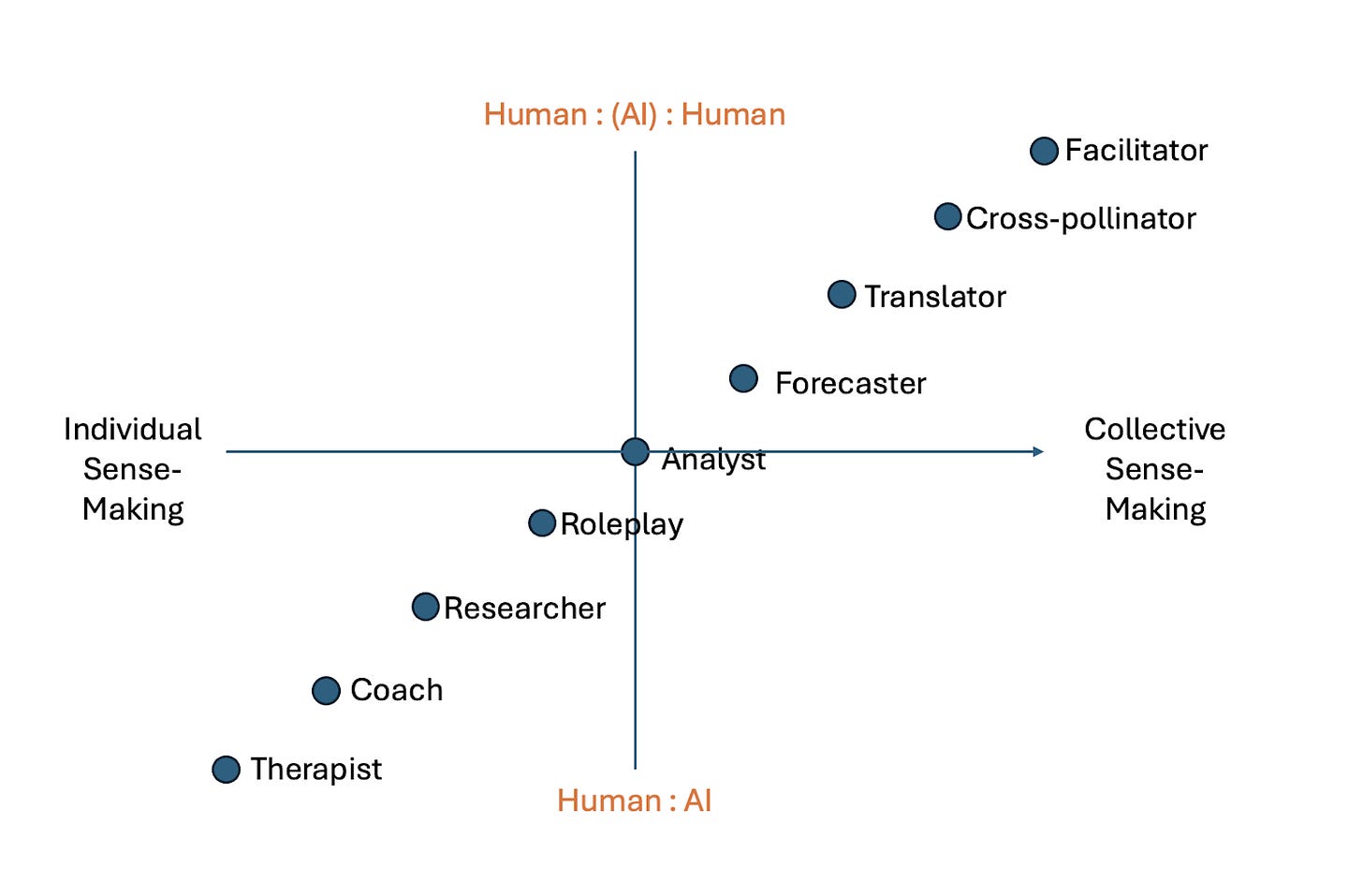AI as a Sense-Making Technology
How modern AI could help us re-learn how to navigate our complex world
Sense-making: Humans’ response to stimuli as they integrate new information into an ever-updating model of the worldWe stand at a convergence where two pivotal moments collide: as a species, we’re facing near-term decisions that could define the fate of humanity (climate change, AI, the political world order, etc.) whilst simultaneously living through a shift where our ability to make sense of the world and each other is rapidly decaying. In a moment where collective coordination is more needed than ever, it feels increasingly impossible to sense-make about problems and solutions.
→ The information systems that once kept us informed are collapsing. Traditional news media continues its long decline as (real and imagined) biases sow distrust; social media platforms that once shone as a hopeful bastion of democracy, connection, and information flow now fall prey to hyper-polarisation, slop, and waves of mis and dis-information; and the rise of generative AI means we could soon enter an age where we no longer fully trust the images and sounds we consume.
→ The institutions that were historically the backbone of connection, peace, and progress continue to lose the trust of the people they’re designed to serve. Faith in democracy is crumbling from both justified anger in false promises and more conspiratorial narratives; a growing anger at the international world order bubbles over, sparked by abuses of power, unequal treatment, and failure of action on pressing issues; and science itself is feeling the backlash against elites through stories of secret plots and malicious misgivings.
→ The social structures historically connecting people deteriorate around us. Rising loneliness and isolation, continuous identity discrimination, and a decline of connection through the communities that once defined social spheres (neighbourhoods, places of worship, employment identities, etc.).
However, possibly not all is lost. Worldwide, efforts to rebuild and reimagine social, professional, digital, and other spaces for the 21st century are afoot. Whilst it’s definitely not the whole answer (and it’s no doubt one of the issues we must now navigate), I believe artificial intelligence could play a vital role in this transition. Modern multi-purpose AI as a conversational and connection technology is still fledgling, but worldwide experiments are exploring possible applications to help us make sense of the world and ourselves. Previous generations of social technology spurred our journey of exploration and connection, and as some now falter, AI could help pick up where they left off and help us move forward.
Individual to collective
We must view sense-making across a spectrum: from the individual to the collective. Individual sense-making (ISM) focuses primarily on self-exploration and reflection to help people better understand our thoughts, feelings, biases, identity, and unique/shared position. Collective sense-making (CSM), on the other hand, orients around interaction with the external world and each other to jointly shape a shared understanding of the structures and narratives of our world. Both are necessary, but whilst ISM is vital for good CSM, alone it’s not enough to support the required action.
The role of AI will differ as we traverse this spectrum. ISM (although informed by outside inputs) is generally a ‘solo activity’, whilst CSM inherently requires more interaction with the outside world. Subsequently, the role of AI will move from being a reflective space for the individual (i.e., 1 person engaging with 1 or more AI systems) to an intermediary amongst people (i.e., 2 or more people engaging with each other with AI as a ‘middle-man’ in some way). This shift is something I’ve written more about here.
In this piece, I’m exploring specific examples of technology to focus on tangible ways this could manifest. I think this is important to help us think practically about the types of technologies we want in the world, rather than simply abstractly about general directions of travel. Below, I have created a basic map of some AI applications as they might fit between these two axes.
Individual Sense-Making
“Knowing yourself is the beginning of all wisdom” - Socrates
To engage effectively with the world, we must first have some insights and convictions through understanding what we ourselves generally think and why. AI that understands context, can engage with huge swathes of information, is trained on a large amount of online information, and easily engages with people through a conversational medium can be a tool to help us think more deeply and reflectively. A lot of this will involved AI playing more of a prompting role than necessarily just information provision - something I explore more in another piece.
Therapist: help people better understand their thoughts, feelings, biases, etc. - overcoming some of the current barriers to access (e.g. cost or social stigmas). People are already using it this way, building products around the concept, and exploring applications in national healthcare services.
Coach: support people to develop more clarity and conviction and move forward into the world with a higher sense of agency. More action oriented than a therapist, this could focus on performance, clarity, key decisions, and much more.
Researcher: help people access and understand more information through search and interface. Elements of this are already being explored in specific products by the likes of Perplexity and is generally one of the most popular uses of mainstream models like Anthropic’s Claude.
Roleplay: bring more voices into the conversation, based on expertise, lived experience, or unique insights, to help people with limited access or capacity engage with (a version of) different viewpoints on an issue. At the lowest level, this is someone asking an AI to ‘tell me how a behavioural economist would respond to this paper’; at the more extreme, this is simulating entire groups for polling or otherwise. This is one of the more contentious applications and something I will likely write more about soon.
Collective Sense-Making
“Collective choice-making requires collective sense-making and collective perspective-taking—I have to be able to understand how other people are seeing things to then be able to work on strategies that are effective together.” - Daniel Schmachtenberger
At the local, national, or international level, the way we tackle many challenges is collectively coordinated action. Housing crises, inequality, climate change, nuclear proliferation, powerful AI, global conflict, these are all things that cannot be handled by one group or body. However, before we can have effective collective action, we must have CSM - understanding the systems at work, the actors in play, the varying context and incentives, and how we as pieces of the puzzle all fit together.
Analyst: gather more information from unique sources and people and help analyse and map information, as well as ideate proposals for action. Explorations around semantic clustering for policy and other domains are on the rise, whilst AI working to generate data, proposals, or briefings will soon be a part of the every-day workflow.
Forecaster: run scenarios with digital twins of systems, collect and collate more ideas from experts and everyday people, and even possibly engage with LLM forecasters directly. Forecasting of some kind has been a large part of decision-making for much collective action (from government using the Delphi method, to amateur traders looking at Wall Street Bets).
Translator: we don’t only need translation for global languages, but to help us understand each other when we come from different backgrounds, expertise, and cultures. AI could help us ground conversations in contexts that make sense to each of us and generate shared language and understanding.
Cross-Pollinator: AI can share ideas where they need to go, helping groups interact with view-points that differ from their own and introduce new perspectives. Recommender systems were an early start to this, but are often optimised for clicks rather than meaningful or bridging engagement - explorations of smart cross-pollination can open doors for better sense-making by sharing information in ways that can drive collective understanding.
Facilitator: AI could guide the conversations we need at scales currently beyond scope for human facilitators. From conversations between small groups of people all the way to large scale digital engagements, we could have larger moderated discourse on the issues that matter.
Conclusion
In the short term, our current tools and systems will continue to degrade and we will soon be in a less recognisable information and social space. Sadly, this feels inevitable.
If we are to navigate our way out of the current predicaments we face, we must become better sense-making animals - both individually and collectively. Fortunately, the research and development of AI within tangible, scalable, well-designed tools could help us navigate some of these new challenges. Much of this work is underway already and it should be our jobs as analysts and technologists to help steer this technology in the right direction.
In many parts of our lives, technology, products, and digital interfaces are the means by which we now interact with the world and we should not underestimate the influence these tools can have on shaping a more positive future.




